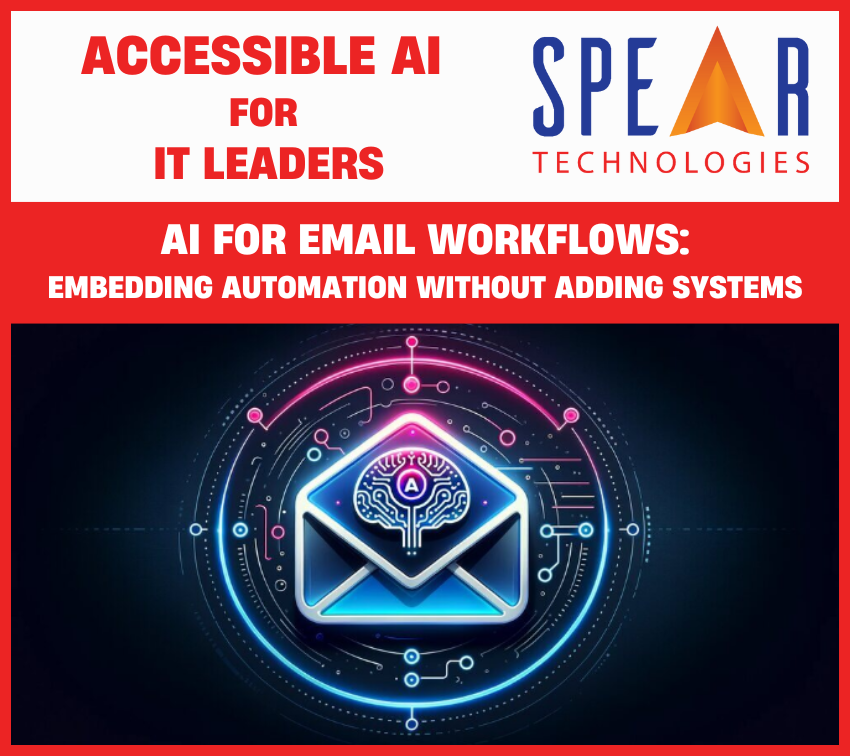Accessible AI for IT Leaders: AI for Email Workflows: Embedding Automation Without Adding Systems

For IT leaders in insurance, inbox overload isn’t just an annoyance—it’s a productivity drain that spans entire organizations. Every day, claims departments, adjusters, and vendors exchange thousands of unstructured emails that contain critical data: loss details, attachments, updates, and questions.
The challenge? These emails live outside of structured workflows. Sorting, routing, and responding require manual effort—slowing operations, creating backlogs, and increasing the risk of missed deadlines or compliance gaps.
Adding another tool or integration isn’t the answer. What insurers need is automation that fits inside existing systems and workflows—without adding more systems to manage.
That’s where Accessible AI comes in.
In this article, we explore how generative AI can intelligently triage, route, and extract data from email communications—freeing IT and operations teams from manual processes, reducing backlogs, and scaling efficiency across claims and vendor networks.
Why Email Workflow Automation Matters for IT Leaders
Across P&C organizations, IT leaders face a common dilemma: how to support growing volumes of unstructured data without creating new dependencies or expanding technical debt.
Emails are often the biggest hidden inefficiency. Each one that contains claim updates, attachments, or vendor inquiries must be reviewed, categorized, and entered into the core system manually—or worse, left in a siloed inbox.
This creates:
- Operational friction as staff handle repetitive routing and data entry tasks
- Inconsistent response times that affect member, claimant, and vendor satisfaction
- Increased risk from communication gaps and documentation errors
By embedding AI directly into existing email workflows, insurers can achieve the automation benefits of a new system—without actually implementing one.
Generative AI tools, such as those available through SpearClaims™, can read, understand, and structure email content automatically; flagging sentiment, prioritizing urgency, and routing messages or attachments to the correct queues.
The result? Fewer delays, better accuracy, and more time for high-value work.
How Accessible AI Streamlines Email Workflows
Accessible AI platforms use natural language understanding to interpret messages the same way a human would – but faster and more consistently.
With embedded automation, AI can:
- Classify and route emails to the correct handler or department based on content and intent
- Extract and attach relevant data (claim number, claimant name, incident date, policy ID) directly into the claims system
- Detect tone and urgency to flag frustrated claimants or high-risk communications for immediate attention
- Trigger workflow actions such as assigning tasks, updating claim notes, or notifying supervisors
Because this automation is layered into the existing email environment, IT teams don’t have to add another platform or manage separate integrations. Instead, the AI connects through lightweight APIs or low-code connectors already supported by SpearClaims™.
Empowering Business Users with AI They Can Shape
Before diving deeper into AI-powered email workflows, it’s worth revisiting the foundation of Accessible AI.
At its core, every use case in this series—including email workflow automation—depends on putting AI in the hands of the business users who know the work best.
In most traditional setups, any change to how email automation behaves—like adding a new routing rule or refining sentiment triggers—requires IT intervention or vendor configuration. This slows progress and limits flexibility.
With Accessible AI, business users can adapt workflows themselves. Claims managers, supervisors, or administrative staff can fine-tune the AI’s logic, retrain models on new patterns, and immediately apply changes—all without coding or vendor escalation.
That’s the power of accessibility: AI that adjusts to business needs, not the other way around.
Why Business-User Accessibility Is a Game-Changer
When AI tools are designed for business users, IT teams gain more than efficiency—they gain alignment.
Empowering non-technical users to manage automation reduces support requests and accelerates improvement cycles. The result is a shared sense of ownership and innovation between business and IT.
- Faster Time-to-Value: No need to wait for vendor updates or custom integrations.
- Higher Accuracy: Business users can continuously refine models to reflect real-world needs.
- Reduced IT Burden: Fewer configuration requests and integration projects.
- Scalable Innovation: Teams across departments can replicate success independently.
Some Tangible Benefits to Empowering IT and Business Teams
The numbers underscore how impactful AI-powered email workflow automation can be for insurers:
- Productivity Boost: Automating email triage and routing can reduce manual inbox management time by up to 45%.
- Operational Efficiency: Embedding AI into existing workflows cuts cross-departmental handoffs and response delays by 30–40%.
- Error Reduction: Structured extraction reduces data-entry and routing errors by up to 60%, improving compliance accuracy.
- Faster Turnaround: Average response times for claimant or vendor emails improve by 25–35%, enhancing service satisfaction and reducing escalations.
With these gains, IT leaders can deliver visible impact across claims, underwriting, and customer service, without expanding the system footprint.
Case Study: Reducing IT Backlog and Improving Partner Experience
A regional property & casualty insurer faced mounting delays in its claims operations. Adjusters spent hours manually sorting incoming emails from members, vendors, and TPAs—many containing attachments and claim updates that required re-entry into the core system.
By implementing SpearClaims™ with Accessible AI, the IT team enabled:
- Automated routing of more than 70% of incoming claim-related emails
- Instant extraction of claim IDs and attachments directly into the core platform
- AI-driven sentiment alerts that flagged frustrated or dissatisfied claimants for early intervention
- A 35% reduction in backlog within 60 days—without introducing any new systems
Result: faster responses, happier claimants, and a measurable drop in internal support tickets.
Why It Matters for IT Leadership
For IT leaders, automation is no longer just about efficiency—it’s about sustainability and control. Accessible AI makes it possible to:
- Modernize workflows without adding integration layers or new maintenance overhead
- Reduce dependency on external vendors for configuration and support
- Empower business users to take ownership of their own process automation
- Maintain full transparency and governance over how AI acts within your ecosystem
By embedding intelligence into existing systems, IT leaders transform automation from a project into a platform capability—scalable, adaptable, and secure.
See Accessible AI in Action
Ready to see how SpearClaims™ can help your IT team streamline communication, reduce backlog, and scale automation—without adding new systems?
Schedule a Demo to see how SpearClaims™ with accessible AI automatically triages, routes, and structures unstructured emails to improve efficiency, accuracy, and response times.
Request Pricing to learn how cost-effective it can be to modernize your workflows, reduce manual effort, and deliver measurable productivity gains across teams.



